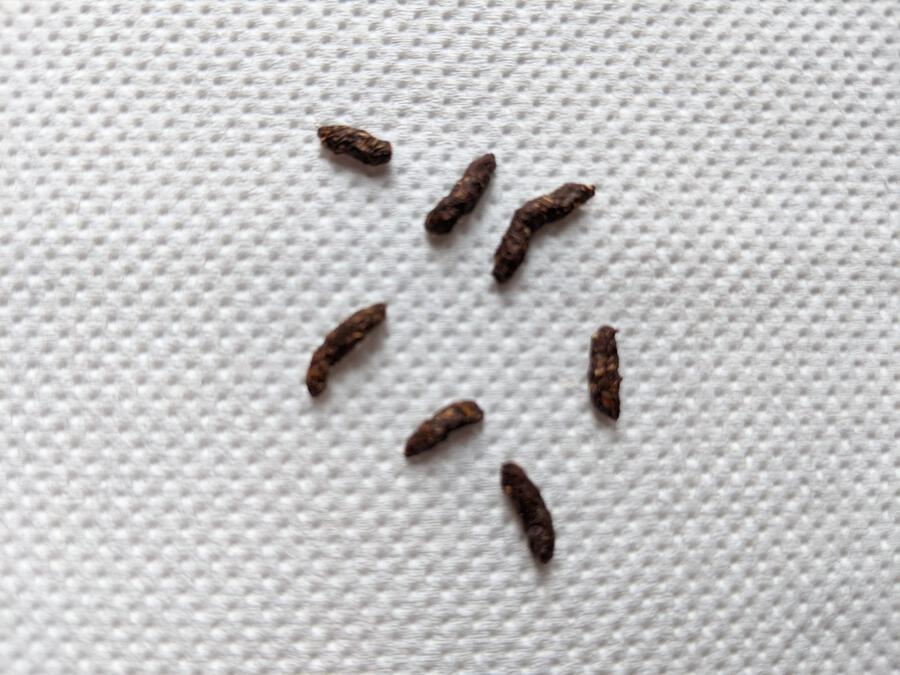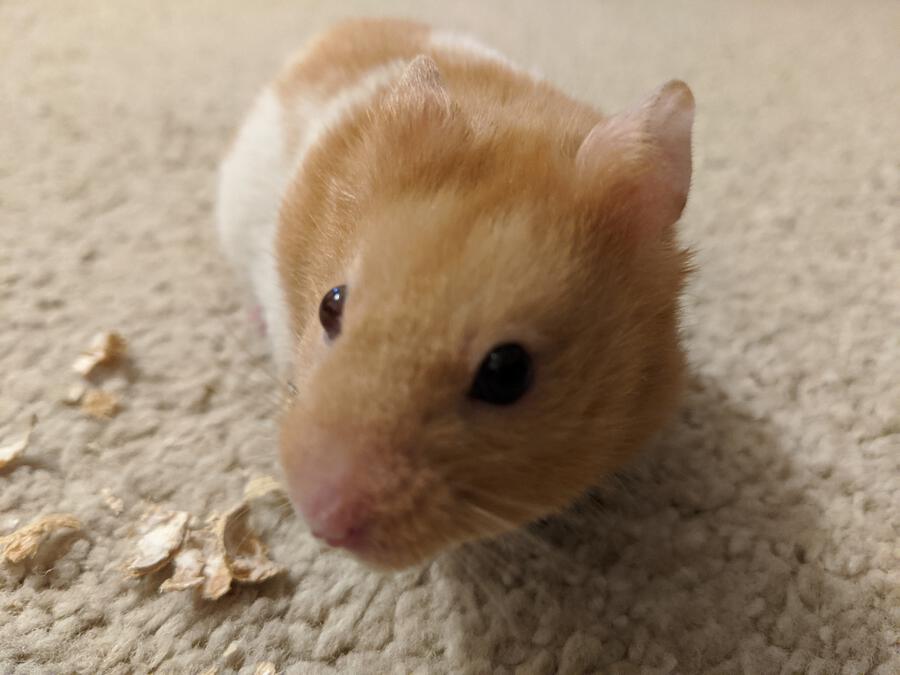When it comes to caring for your pet hamster, it’s normal to consider the obvious things such as food, water, exercise, bedding etc. Although these things are important, it’s a good idea to look out for signs of illness too. This will enable you to sort the problem out before it becomes life threatening.
One telltale sign that there may be a problem with your hamster, is if you notice changes in your hamsters poop. In order to notice any changes, it is a good idea to know what healthy hamster poop should look like normally.
So what does healthy hamster poop look like?
Hamster poop looks like small, dark, oblong pellets that are dry and firm. Healthy hamster poop isn’t moist, doesn’t smell and does not leave any trace or stains behind.
If you feed your hamster a basic food mix, like this from Amazon (#CommissionsEarned), then that is what your hamster poop should look like, because that is generally all we feed to our hamster. We do feed him slices of apple from time to time and maybe a little chicken, but it’s not very often, maybe once every two to three weeks.
Now, you’ve asked for it, here’s a picture of ‘normal’ hamster poop! (Yuck)

Table of Contents
Hamster poop color
Hamster poop is normally a dark color like black or brown when your hamster isn’t ill and healthy. However, a change in the color of your hamster’s poop usually indicates either a change in diet.
You may think that your hamster’s diet hasn’t changed much but if you have used a different mix, even though they may appear similar, they are different and a sudden change can upset your hamster’s stomach.
Alternatively, it may be that some of the treats you have given to your hamster are to blame. If you think this is the case, stop giving your hamster the treats for a few days and see if your hamster’s poop returns to normal.
But generally, if there is no diarrhea, mucus or bad smells present and your hamster’s appetite and behavior is mostly the same, then your hamster should be okay.
If you do notice any diarrhea, and your hamster’s poop looks pale in color and watery, then your hamster may have diarrhea. This could be a result of either a change in diet or an infection/disease.
In this case then you should get it checked over by your vet.
Why is my hamster poop green?
People have reported on a number of forums, like this thread here, that their hamster’s poop is green.
Although it can be alarming and worrying to see that your hamster is producing green poop, chances are there is nothing to worry about as often, it can be quite natural.
The mostly likely cause of green hamster poop is green leafy vegetables. The reason being is that any vegetable with green leaves contains Chlorophyll, which is a green pigment that is required for photosynthesis in plants, algae and cyanobacteria.
Another reason could be your hamster’s food mix. Some food mixes can contain food coloring, which can give your hamster’s poop weird and wonderful colors.
If that’s the case, try using a mix that doesn’t contain too many colors and see how it goes. Try to keep your hamster’s diet consistent and if you’re still concerned after a day or two, then contact your vet.
Is hamster poop harmful to humans?
Generally, it is not thought that hamster poop is particularly harmful or dangerous to humans.
However, there is a virus known as the Lymphocytic Choriomeningitis (LCM) virus which is mainly found in the common house mouse but has been reported in other rodents too such as hamster’s. Although this is not as common.
It is estimated that about 5% of house mice in the US carry LCM and they are all capable of transmitting the virus at some point during their lifetime. This however, isn’t very obvious, as they don’t show any signs of illness.
Although it is not as common in hamsters, they can get the virus from wild mice that might be present at the breeder, a pet shop or even in the home.
Mice and hamsters harbor the virus which is subsequently excreted from their body via their urine, feces or semen. It can also be found in nasal secretions.
Unfortunately, humans are capable of contracting LCM either from exposure to dust or food which has been contaminated by a house mouse or hamster.
Humans can also contract LCM through airborne particles of a rodent’s urine, feces or saliva.
LCM mostly affects young adults and children and most people recover completely.
Prevention
In order to avoid contracting LCM, avoid direct contact with hamster and mouse feces. Also, make sure that your hamster’s cage is cleaned out regularly to prevent buildup of dried feces which can become airborne.
When handling your hamster, it is also a good idea to wash your hands with soap and water afterwards.
This also applies if you come into contact with your hamster’s cage or bedding.
Can hamsters Get diarrhea?
Yes, hamsters can have Diarrhoea. It is fairly obvious when they do because their poop or feces will be loose and watery and you may notice that the rear end of your hamster is soiled and damp.
Diarrhoea is a common condition but it can also be a symptom of an underlying disease so it’s important to get it treated quickly especially since any resulting dehydration can be fatal.
There are certain infectious cases of diarrhea such as Wet Tail, Salmonella, Tyzzer’s Disease and Yersinia etc.
These infectious cases can cause severe illness in your hamster and can cause your hamster to be hunched over in an uncomfortable position. Your hamster will also refuse to eat or move.
In less severe cases you may notice some weight loss and your hamster may be more thirsty than usual. If the diarrhoea has been caused by diet then your hamster will often continue to eat.
Some of the causes for diarrhoea include a sudden change in diet, wet green food, food straight from the refrigerator, too many laxative plants such as Dandelion or Groundsel and some antibiotics have also been known to induce diarrhoea.
It’s important to ensure that there is water available for your hamster at all times to counteract the dehydration and in some serious cases, you may have to provide oral rehydration fluids to your hamster every hour.
Finally, try to avoid giving your hamster food for 24 hours, check your hamster’s diet to see what may have caused the diarrhea and make sure you don’t give your hamster any green foods until 2 to 3 days after your hamster has fully recovered.

Why does my hamster poop on me?
Whilst we’re on the subject of poop and because this happens to me from time to time, I thought I’d mention why hamsters will often poop on you.
Don’t take it personally, hamsters will poop on you, poop in their bed and poop generally wherever they feel like it.
But this is perfectly normal and as hamsters don’t have the same bowel control as humans do and when they ‘need to go’, they go, it’s as simple as that.
Although this doesn’t happen all the time, our hamster Richmond tends to poop me when I’m handling him and hears unfamiliar noises, although he’s done this less recently (maybe he’s getting braver now he’s getting older!)
If he is frightened by something and continues to poop, I tend to put him back in his cage again where he feels safe and secure.
As a side note, new hamsters can also poop a lot when they’re frightened and unfamiliar with their environment.
Wrapping up
Caring for your hamster sometimes involves doing things that aren’t particularly pleasant.
One of those things is looking at your hamster poop to make sure there is nothing untoward. Knowing what normal hamster poop looks like, can certainly help you recognize this.
In addition to what hamster poop generally looks like, I’ve also addressed the colour of hamster poop and what happens if you notice that your hamster poop is green.
We’ve also established that hamster poop can be potentially harmful to humans, which is why it is important to wash your hands after handling your hamster or putting your hands inside your hamster’s cage.
I have also addressed the subject of diarrhoea, which, although it’s fairly common to hamsters, it could indicate a more serious condition.
Generally though, a lot of the problems with hamster poop and health can be solved with a good diet and plenty of water.
Try to keep hamster treats to a minimum and try to stick to pre-mixed hamster food as much as possible. This will ensure your hamster has a balanced diet which is unlikely to cause stomach upset.
